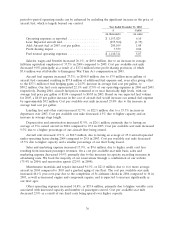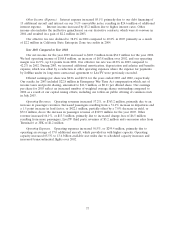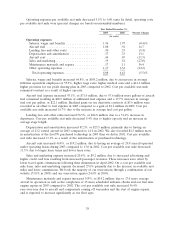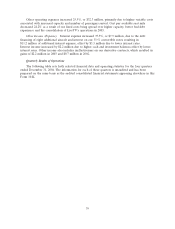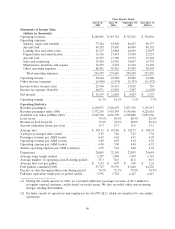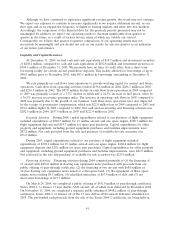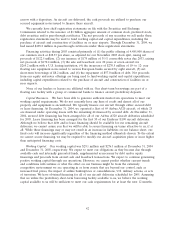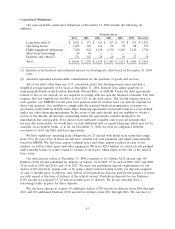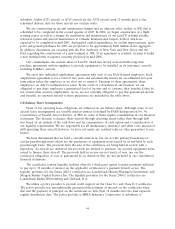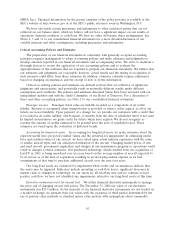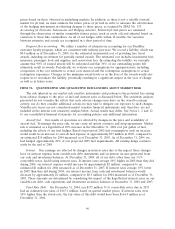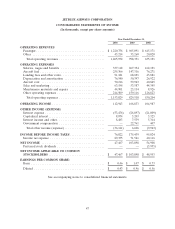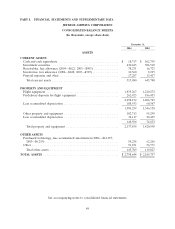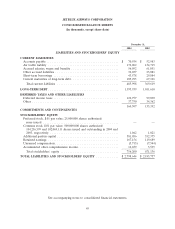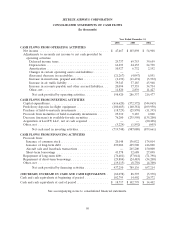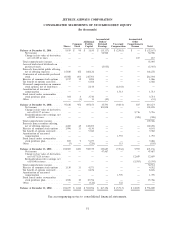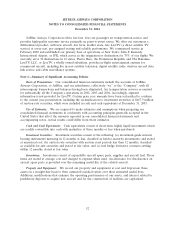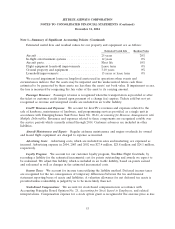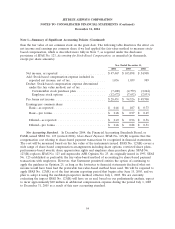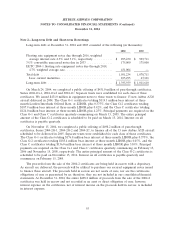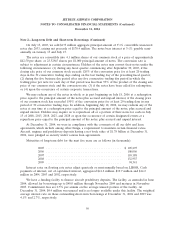JetBlue Airlines 2004 Annual Report Download - page 54
Download and view the complete annual report
Please find page 54 of the 2004 JetBlue Airlines annual report below. You can navigate through the pages in the report by either clicking on the pages listed below, or by using the keyword search tool below to find specific information within the annual report.prices based on those observed in underlying markets. In addition, as there is not a reliable forward
market for jet fuel, we must estimate the future prices of jet fuel in order to measure the effectiveness
of the hedging instruments in offsetting changes to those prices, as required by SFAS No. 133,
Accounting for Derivative Instruments and Hedging Activities. Forward jet fuel prices are estimated
through the observation of similar commodity futures prices (such as crude oil) and adjusted based on
variations to those like commodities. As all of our hedges settle within 12 months, the variation
between estimates and actuals are recognized in a short period of time.
Frequent flyer accounting. We utilize a number of estimates in accounting for our TrueBlue
customer loyalty program, which are consistent with industry practices. We record a liability, which was
$0.8 million as of December 31, 2004, for the estimated incremental cost of providing free travel
awards, including an estimate for partially earned awards. The estimated cost includes incremental fuel,
insurance, passenger food and supplies, and reservation fees. In estimating the liability, we currently
assume that 90% of earned awards will be redeemed and that 30% of our outstanding points will
ultimately result in awards. Periodically, we evaluate our assumptions for appropriateness, including
comparison of the cost estimates to actual costs incurred and the redemption assumptions to actual
redemption experience. Changes in the minimum award levels or in the lives of the awards would also
require us to reevaluate the liability, potentially resulting in a significant impact in the year of change
as well as in future years.
ITEM 7A. QUANTITATIVE AND QUALITATIVE DISCLOSURES ABOUT MARKET RISK
The risk inherent in our market risk sensitive instruments and positions is the potential loss arising
from adverse changes to the price of fuel and interest rates as discussed below. The sensitivity analyses
presented do not consider the effects that such adverse changes may have on the overall economic
activity, nor do they consider additional actions we may take to mitigate our exposure to such changes.
Variable-rate leases are not considered market sensitive financial instruments and, therefore, are not
included in the interest rate sensitivity analysis below. Actual results may differ. See Notes 1, 2 and 12
to our consolidated financial statements for accounting policies and additional information.
Aircraft fuel. Our results of operations are affected by changes in the price and availability of
aircraft fuel. To manage the price risk, we use crude oil option contracts and swap agreements. Market
risk is estimated as a hypothetical 10% increase in the December 31, 2004 cost per gallon of fuel,
including the effects of our fuel hedges. Based on projected 2005 fuel consumption, such an increase
would result in an increase to aircraft fuel expense of approximately $33 million in 2005, compared to
an estimated $14 million for 2004 measured as of December 31, 2003. As of December 31, 2004, we
had hedged approximately 20% of our projected 2005 fuel requirements. All existing hedge contracts
settle by the end of 2005.
Interest. Our earnings are affected by changes in interest rates due to the impact those changes
have on interest expense from variable-rate debt instruments and on interest income generated from
our cash and investment balances. At December 31, 2004, all of our debt, other than our 31⁄2%
convertible notes, had floating interest rates. If interest rates average 10% higher in 2005 than they did
during 2004, our interest expense would increase by approximately $2 million, compared to an
estimated $1 million for 2004 measured as of December 31, 2003. If interest rates average 10% lower
in 2005 than they did during 2004, our interest income from cash and investment balances would
decrease by approximately $1 million, compared to $0.5 million for 2004 measured as of December 31,
2003. These amounts are determined by considering the impact of the hypothetical interest rates on our
variable-rate debt, cash equivalents and investment securities balances at December 31, 2004 and 2003.
Fixed Rate Debt. On December 31, 2004, our $175 million 31⁄2% convertible notes due in 2033
had an estimated fair value of $167.1 million, based on quoted market prices. If interest rates were
10% higher than the stated rate, the fair value of this debt would have been $164.4 million as of
December 31, 2004.
46


